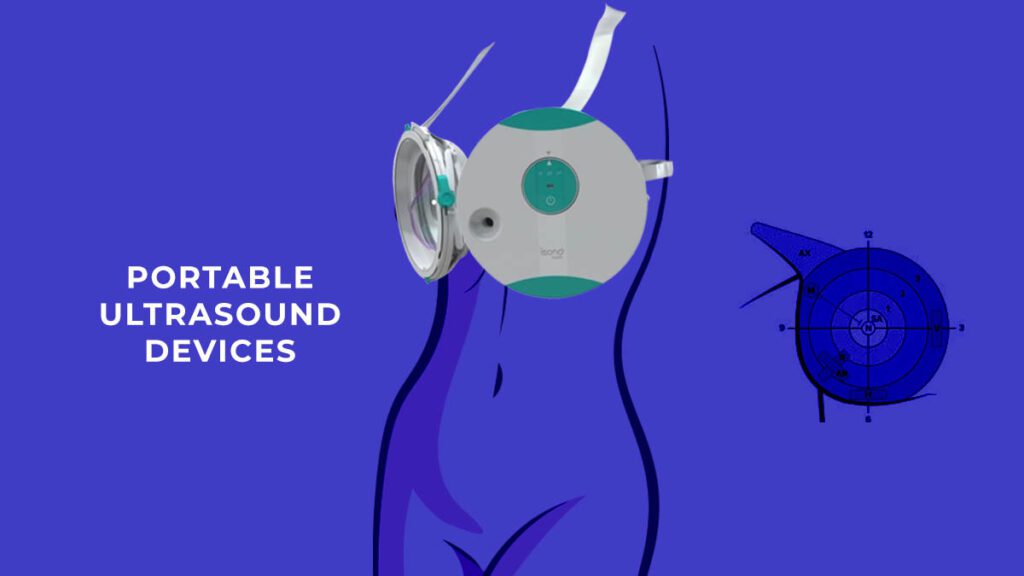
The medical field has been benefiting a lot from technological advancements. The diagnostic, monitoring, and treatment tools have been getting smaller in size with ubiquitous usage capabilities and smarter decision-making. Ultrasound technology uses sound frequencies outside the human audible band, that is, above 20 kilohertz. These safe waves are reflected from body structures, and processed by a computer to produce a picture of the intended organ or structure. Recently, portable ultrasound devices have emerged in the market allowing a practical usage of this popular technology. As is the case with wireless electroencephalogram (EEG) headsets or most recently earbuds, and other continuous measurements techniques that rely on sensors placed in contact with the body, numerous benefits can be achieved through an accurate and close follow-up of various medical conditions. The democratization of healthcare is another important side-effect as costly services can now be available to the public at affordable prices.
Can I Do My Ultrasound at Home?
The advances of technology will soon allow solutions at home that do not require a specialist operating the machine. Think about it in a similar way to blood pressure measurement devices that can be worn on the wrist, or even diabetes management devices that are placed on the body surface or subcutaneously under the skin. The more plausible question is whether the measurements would be reliable and accurate. The aforementioned question is answered through technologies that allow the development of small electronic devices, such as transducers, that will faithfully capture data, similarly to large traditional machines and devices. There has indeed been much progress in that direction. In 2019, a group of researchers in the university of British Columbia in Canada, have developed a portable ultrasound transducer, the size of a plaster, that can be woven into clothes or even integrated into small machines. The cost of the device has been estimated at a mere USD 100. The possibility of personal use depends on the advanced processing and analytics algorithms that can be applied. Processing of the data is needed to produce accurate representation of the organ or structure being investigated while advanced artificial intelligence are needed to interpret the collected data and give the individual a preliminary decision regarding his medical status. Finally, wireless connectivity is needed to connect the sensing devices to a smartphone to process and display the required information.

Do Portable Ultrasound Systems Exist?
Many unique devices are emerging in the market for a multitude of applications. A few years ago, General Electric has launched a portable ultrasound scanner, the Vscan. The device has been subsequently employed to tackle child mortality in Africa. Several other notable products are available on the market.
Butterfly iQ+
Butterfly iQ+ is a portable ultrasound scanner device that can be directly connected to a smartphone or tablet through a proprietary Apple Lightning connection or USB type-C connection. The package comes with a myriad of services including various imaging possibilities, unlimited cloud storage, and a possibility for telemedicine services. The features of the device, which is priced at around USD 2400 have been tested for a large number of medical applications including anesthesiology, cardiology, emergency medicine, obstetrics, and many more. Additional analytics provide insights directly on the smart device.
iiSono Health
iSono Health has recently obtained the Food and Drug Administration (FDA) approval for its wearable breast ultrasound imaging apparatus, named ATUSA. The system can be comfortably worn by the subject and images can be obtained in less than two minutes. Two- and three-dimensional images can further be analyzed through an AI-based software than can assist the physician with the decision-making process. This device is of notable importance for individuals genetically predisposed or having breast cancer as it allows screening at increased interval. This will further improve the control of the disease.
Coso
Male contraception is another application where ultrasound portable devices are used. Traditional approaches to contraception include male contraceptive pills, vasectomy, or the traditional condom usage. What Coso does is halting sperm regeneration through an ultrasound-based mechanism. The designed device is filled with water, which is then heated by the device to the required temperature. The subject’s testicles are then placed in water and subject to ultrasound waves which will induce the contraceptive effects which temporarily last for a couple of months, two weeks after the treatment is given. This indeed could be a solution that replaces hormonal-based pills or surgical-based vasectomies, providing a temporary contraceptive effect.
Sustained Acoustic Medicine
Sustained acoustic medicine (SAM) is a therapeutic approach that uses low intensity long duration ultrasounds to heal soft tissues. This biomodulation technique has been used to treat chronic pain and other musculoskeletal injuries, notably for athletes. Many products have been released that use this ultrasound-based technology and some are already available on the market. Among other, companies such as Kinex and Zetroz have developed such projects using specially designed patches that could be placed on the injury location. Zetroz research and development is supported by entities such as the US Department of Defense.
Summary
Ultrasound based treatments are no longer confined to hospitals and specialized centers. The advances in technology have paved the way for portable ultrasound devices, that can be used at a relatively low cost, everywhere. The addition of AI-based analytics and wireless connectivity further helps in monitoring medical conditions while assisting in the assessment process.
“Inside Telecom provides you with an extensive list of content covering all aspects of the tech industry. Keep an eye on our MedTech, AI and Technology space to stay informed and up-to-date with our daily articles.”